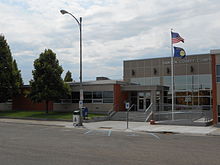Dawson County, Montana
| Dawson County, Montana | |
|---|---|

Dawson County Courthouse in Glendive
|
|
 Location in the U.S. state of Montana |
|
 Montana's location in the U.S. |
|
| Founded | January 15, 1869 |
| Seat | Glendive |
| Largest city | Glendive |
| Area | |
| • Total | 2,383 sq mi (6,172 km2) |
| • Land | 2,372 sq mi (6,143 km2) |
| • Water | 11 sq mi (28 km2), 0.5% |
| Population (est.) | |
| • (2015) | 9,625 |
| • Density | 3.8/sq mi (1/km²) |
| Congressional district | At-large |
| Time zone | Mountain: UTC-7/-6 |
| Website | www |
Dawson County is a county located in the U.S. state of Montana. As of the 2010 census, the population was 8,966. Its county seat is Glendive.
Dawson County is one of the older counties of the state. It was created January 15, 1869 from the northern half of the original Big Horn County. The namesake of the county is Major Andrew Dawson, manager of the Fort Benton Trading Post for the American Fur Company from 1856 to 1864.
According to the U.S. Census Bureau, the county has a total area of 2,383 square miles (6,170 km2), of which 2,372 square miles (6,140 km2) is land and 11 square miles (28 km2) (0.5%) is water.
Dawson County is located in the extreme eastern portion of Montana, about fifteen to twenty miles west of the Dakota line.
Dawson County contains part of Montana's badlands. Makoshika State Park is a great example of the unusual rock formations. Yellowstone River runs through the county.
The principal sources of the water supply in Dawson County are the Yellowstone River, which bisects the southeastern half of the county, and the Redwater River, which flows through its extreme northwest townships. Numerous large and small creeks are tributary to these streams, furnishing abundant and accessible facilities not only for watering livestock, but also for small individual irrigation enterprises, and water conservation projects. In the upper bench lands, artesian well irrigation has received considerable attention.
Parts of Dawson County were taken to form Valley County in 1893, Richland County and part of Wibaux County in 1914, part of Prairie County in 1915, and Garfield County and part of McCone County in 1919.
...
Wikipedia
